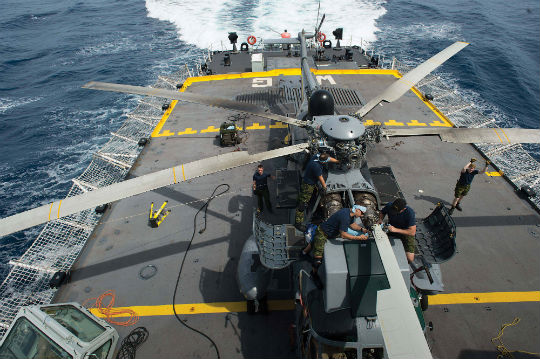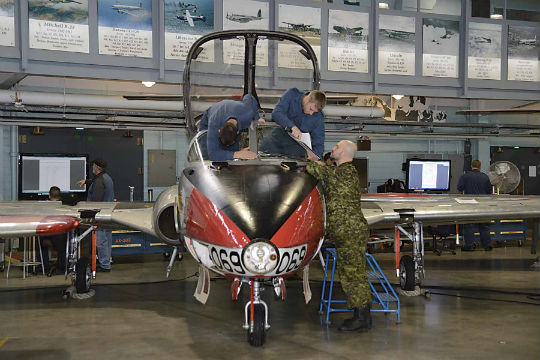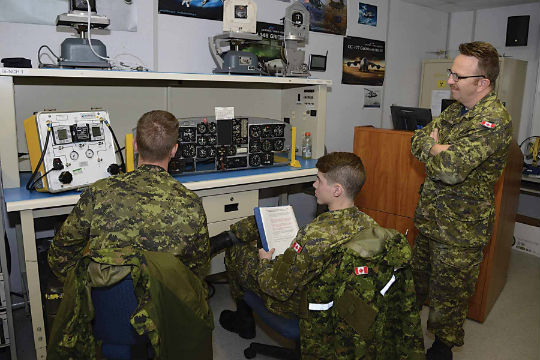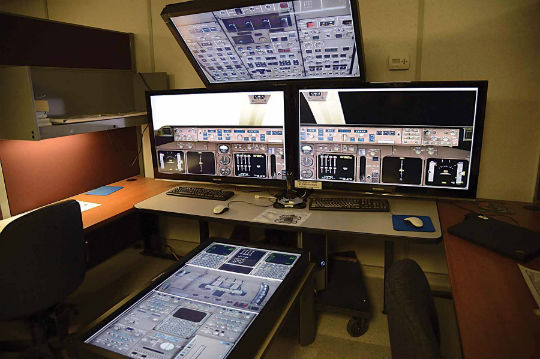Estimated reading time 15 minutes, 11 seconds.

Aviation systems technicians from HMCS Winnipeg prepare to replace a rotor blade on a CH-124 Sea King. DND Photo
Walk the hangars of the Canadian Forces School of Aerospace Technology and Engineering (CFSATE) at 16 Wing Borden, Ont., and it’s hard not to see the paradox: aircraft that are among the oldest in the Royal Canadian Air Force (RCAF) serve as the training template for technicians who will one day maintain and repair some of the most complex and sophisticated fleets ever built.
The CT-114 Tutors that dot the hangar floors—and the training aids in classrooms and workshops based on the 50-year-old Canadair aircraft—are hardly representative of the flight lines on which most of the students will one day work. There, new J-model Hercules, advanced F-model Chinooks, CC-177 Globemaster IIIs and, eventually, long-range unmanned platforms and perhaps fifth generation fighters, will become their forte.
Like the Mercedes-Benz F 015 autonomous car or Google’s self-driving vehicle, many aircraft are becoming flying computers—the F-35 reportedly has almost nine million lines of software code. So the future technicians may be more software engineer than aeroplane mechanic.

From old to new: CFSATE graduates may find themselves working on legacy aircraft, such as the CH-124 Sea King helicopter (main photo), or cutting-edge modern machines such as the CC-177 Globemaster III (shown here with techs at 8 Wing Trenton). Mike Reyno Photo
This technological change is not unexpected. Through new training methodologies and an air force-wide simulation strategy, the RCAF has been anticipating the requirements to “force generate” its air crews and technicians for the demands of modern fleets, fully cognizant of the technology permeating new aircraft.
But there’s a catch: Today’s aircraft technicians must be able to service legacy fleets of Tutors—still performing with the Snowbirds air demonstration squadron—as well as 50-year-old Sea King helicopters and a few remaining H-model Hercs, even as they adjust to newer platforms.
So, despite the emphasis on high tech, fundamental diagnostic and mechanical skills still apply.
“If we have multi-million-dollar aircraft sitting on the ground because a central maintenance computer isn’t telling a tech what to fix, somebody has got to be able to (figure out the problem) and fix that,” said WO Howard Honka.
LEARNING THE BASICS
CFSATE’s roots run deep, back to World War I when Camp Borden became the first Canadian flying station of the Royal Flying Corps. The school itself was officially stood up in 1985, but the base has been the foundational training ground for all RCAF aircraft technicians since the 1920s.

Avr Brown solders circuitry components onto a circuit card. Sgt Christopher Bentley Photo
This fiscal year, more than 400 students will go through the various programs. They will graduate with basic skills in aircraft avionics, structures and safety systems, weapons systems or aviation systems, and then move on to master the intricacies of specific aircraft. This is accomplished through specialized on-the-job training at flying squadrons across the country.
As that important first step, the school must ensure students have both a primary understanding of the techniques, procedures and tools required to perform basic maintenance and repair, as well as a wider comprehension of how integrated systems relate.
The Tutor provides a sound platform for tracing wiring faults, testing cockpit avionics systems, repairing the elements of wing structures, and aligning engines. Its straightforward construction and its quirks—manual flying controls with spring tabs and a turbojet engine that is not solid-mounted—provide both a challenge and a level of comfort for first-time students.
“We want (students) to use their brain to learn the basics,” explained Sgt Carl Coney, the air maintenance section lead. “If you are in Afghanistan and the plane is down, you might have to go back to those basics. The Tutor is a simple plane to work on.”

AVS students learn radar principals. Sgt Christopher Bentley Photo
“I can’t think of starting with anything more complicated,” added Aviator Cameron Carter, an apprentice avionics technician. “I found it a little overwhelming the first time I opened up a panel, but once you get the hang of it, it becomes more natural.”
However, the Tutor was never designed as a technician’s training aid—panels and wiring often have to be repaired before students can begin learning how to repair them. So while it may meet its intended purpose, more advanced training systems and part-task trainers will eventually be required.
Honka, a career air maintenance supervisor, is leading a team conducting concept design for a modern training plan and training aids for the school’s avionics program. Tight RCAF budgets will influence how it rolls out, but the goal is to “put our technicians on the most modern training aids possible,” he said.
“In identifying what we want to train, we look at the fleets we have and we also try to look forward (to emerging technology). We are the step between putting them out on the flight line on that aircraft, so we need to prepare them for that technology.”

CFSATE instructor Cpl Aaron Pledger works with a student on a Tutor. Sgt Christopher Bentley Photo
While some of that tech might seem better suited to an IT graduate, Honka noted that most students arrive at CFSATE with an innate feel for computers; the same can’t always be said for a socket wrench.
“In avionics, you have to bring both together. You have to be good with your tools, but you also have to be able to comprehend and work with a flying network.”
Getting students to that stage is a series of small steps, not a “giant leap,” said Maj Derek Bjorndalen, CFSATE’s deputy commandant. It requires the deconstruction of complex systems into manageable building blocks to ensure students understand each component. “Our big goal is to make sure the training meets what is needed at the other end in the field without pushing too much onto those operational training units. As the aircraft are advancing, we definitely see the need (for more technology) in our training. In the last five years, our quality standards have been reviewed and updated and that’s driving an update to a lot of our training.”
At a time when the RCAF is approaching C4ISR (command, control, communications, computers, intelligence, surveillance and reconnaissance) as a system of systems in which every sensor is a node on the network, it might seem counterintuitive to break avionics systems into separate components, but that has been a necessary step to the training, said Honka.
“At one stage, we were trying to train the aircraft as a whole and it was too overwhelming. We needed to pull the systems apart and then build them back together as an aircraft, so that at the end of the course the students are seeing that all (the systems) have to work together: the flight director doesn’t do anything unless it has some inputs from the air data computer; the autopilot does next to nothing unless the flight director is giving it commands. We want the students to realize that if the autopilot isn’t engaging, it doesn’t mean you swap out the autopilot. It may be the air data computer that is causing the autopilot not to engage.”

A CFSATE instructor and course director describe aircraft structure technician training for RCAF Today. Sgt Christopher Bentley Photo
Tour CFSATE’s avionics classrooms and labs, and you will quickly appreciate how those fundamentals are being instilled, and how technology is changing teaching methodology.
The nine-month avionics course is composed of nine components or performance objectives that incorporate theory and practical experience. Students arrive with some understanding of wiring diagrams, testing and fault finding from the BET (basic electrical training) component of common core—the initial entry program every student must complete—but it is here that they learn to test the electrical components of a Tutor cockpit, splice and solder wire, wire a console, understand radar systems and, for many, encounter new tools such as heat guns and testing and calibration equipment.
The final courses, though, bring students back to a system-of-systems mindset, providing firsthand experience with systems integration and how problems in one can affect the performance of another, said Sgt Eric Prevost, the avionics training course director. In automatic flight control systems, a 23-day program, students work in a simulated environment to solve problems in a modern cockpit. Like a gaming console for pilots, the system replicates auto-flight functionality—autopilot, flight director, auto throttle, flight management—and can introduce upwards of 150 different faults down to the component level.
“With a typical autopilot system, you have a lot of systems that feed into it,” explained Herbert Romer, an instructor with Calian Technologies. “So (is the problem) in the source system or in a system that feeds into it? How you break it down, how you fault find is the big piece here.”
“It allows us to get across the concepts,” added MCpl Lyle Mason, an avionics instructor.
INTERACTIVE E-LEARNING
One of the more innovative changes can be found in a project called Air Technician Training Renewal (ATTR), an effort to blend e-learning with more traditional practical experience by using multimedia—everything from game shows to online gaming—to help students understand equipment, parts and procedures. From 360-degree views of components to interactive videos on proper processes, the modules encourage a range of problem solving that caters to younger students.
“When you just use talk and chalk or sage on the stage, there is very little flexibility in delivering the learning,” explained Maj Paul Monahan, manager of the project and CFSATE’s training development squadron commander. “Technology gives us other off-ramps for that. It also takes into account that there are different types of learners in a class, and they acquire learning in different ways.”
The online courseware is being developed in partnership with Calian Technologies. Co-located at CFSATE, a team of instructional designers, e-learning developers, military subject matter experts and project leads are capturing teaching points and student objectives of each course and selecting the most appropriate media to convey the lesson in an engaging but standardized product.
Since most courses are performance-oriented, there are limits to what can be conveyed online. But ATTR is changing how sometimes bland information is delivered. “A good instructor can make the phone book interesting, but that’s an exceptional person,” Monahan said. “With e-learning you can spice up dry topics if you do the proper structural design. That is where we have leveraged it the most.”
To date, ATTR has been applied to common core and online modules are being developed for the air weapons (AWS) and avionics (AVS) courses. The school would like to progress to more complex challenges such as simulating trouble shooting of avionics faults, but “a lot of capital has to go into that,” Monahan observed.

CFSATE instructor MCpl David Jamieson works with students on a pitot static training aid. Sgt Christopher Bentley Photo
While ATTR has helped reduce the length of common core from 75 training days to 45, despite a 35 per cent growth in course content, Bjorndalen said blended learning has not affected the length of most courses, especially avionics, which have increased as new material related to modern aircraft has been incorporated.
But there is potential to reduce travel and residential costs and “force generate” technicians more rapidly through the growth of distance learning. Over the past six years, CFSATE has migrated a number of courses—or parts of courses—online. It’s not a replacement for hands-on training, but it can supplement most programs, according to MCpl James Wood, a distance learning administrator.
As an example, he points to a course on aircraft battery second line maintenance that used to be held over two weeks at the school. It is now comprised of a five-hour online course and an on-the-job training (OJT) portion at the student’s unit. A technical data control course that was previously delivered in-house is now a two-hour online program, followed by an OJT package that can be completed within a year at the unit. Others, such as an ammunition and explosives management course, include both distance learning and residential components, allowing students to develop an understanding of key concepts before arriving at CFSATE.
Distance learning allows fast learners to progress through course material more quickly, Wood observed, but it also “bridges a technology gap” by giving those with fewer computer skills the opportunity to learn at their own pace.
Making more course material available online has two additional benefits: students can “refresh” their training at any time once they are assigned to their squadrons—course books and binders often gather dust on a shelf or wind up in the garbage, Wood noted—and training modules and lesson plans can be updated as soon as new information comes in.

A touch screen AVS automatic flight control systems trainer. Sgt Christopher Bentley Photo
“It is a lot more fluid then it ever was. Before, if you had to make a change in a course, you had to fill out a form that would go (through a lengthy process) before an amendment was approved. Now, it can be done within a day.”
If there is a surprise amidst the growing use of smartboards and other classroom technology, it’s that paper is still popular. In the aircraft structures and safety program, for example, most course material is accessible from a student’s laptop; which, with the development of online training modules, has cut training days by half for processes like using a paint gun.
“You would think today the younger generation would prefer working off laptops but that is not always the case,” Sgt Tony Gale, a course director, observed. “I’m an old dog who went through using paper versions and we’re finding the students still like that.”
Aviator Robert Carlson admits to a preference for paper for some tasks, but added that “once everything gets fine tuned it is going to be an excellent system.”
COMPLEX YET SIMPLE
It’s easy to assume that the complexity of current and next generation aircraft systems will require more advanced training aids. Monahan isn’t so sure. He cautioned that there is a danger the air force could over-train its students for what is actually required on the flight line. The F-35 engine, for example, features 400 sensors that determine its health and performance and can feed diagnostic data to the ground before the fighter jet lands, including a request for parts.
“These systems are becoming more complex but they are also becoming in some ways simple,” he explained, noting that a properly maintained system requires little more than a press of the button to identify a problem. “We have to adapt to that. We may find ourselves over-training when we are teaching every system on an aircraft. We may have to teach students less (about a system) and more about how to use all the tools that go with it.”
For now, though, with fleets marking a half century of service, including the one that serves as the RCAF’s technician training platform, the basics still matter. CFSATE will turn to more technology for its training, but a lot of problems can still be solved with a solid technical foundation.

